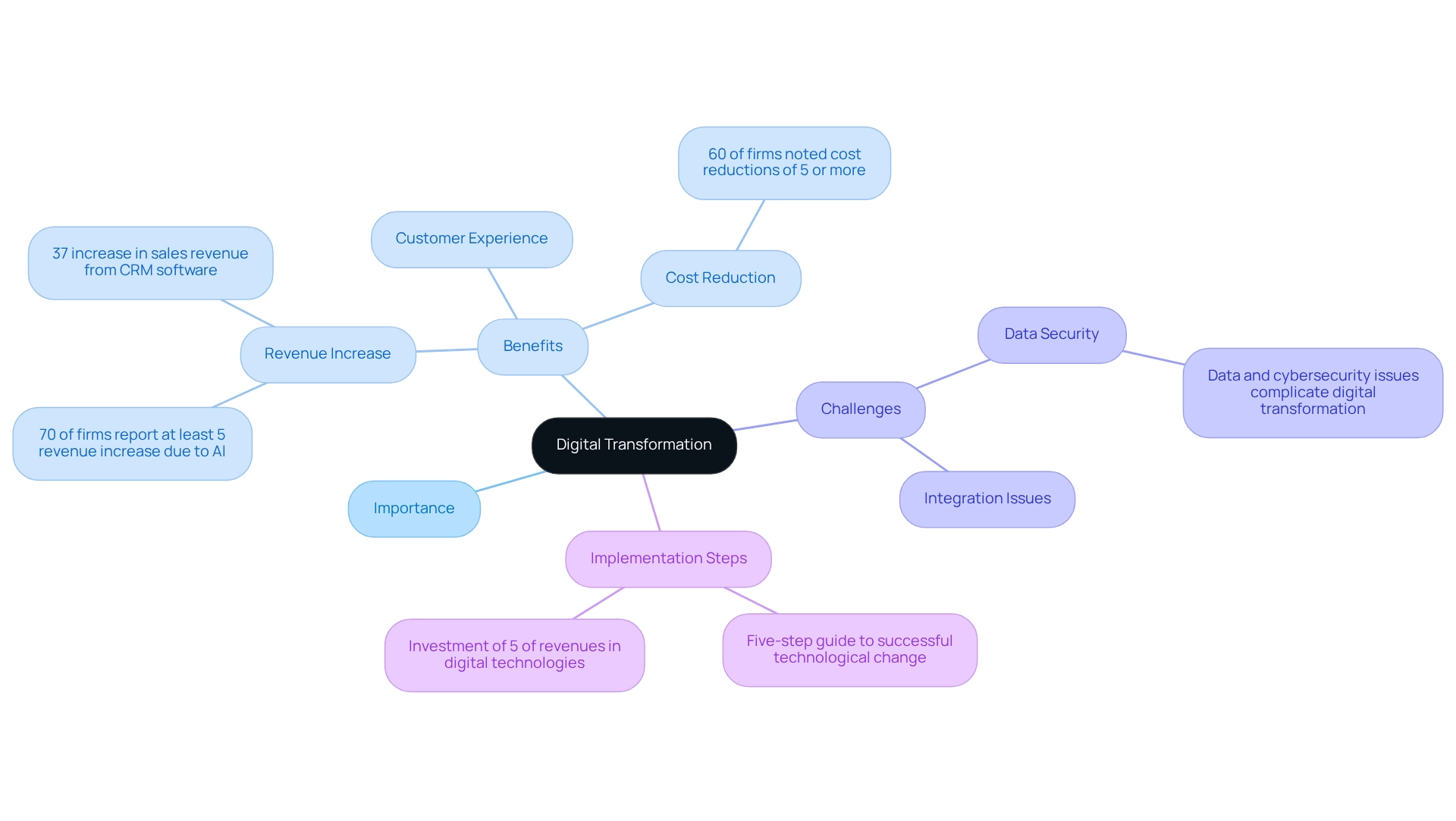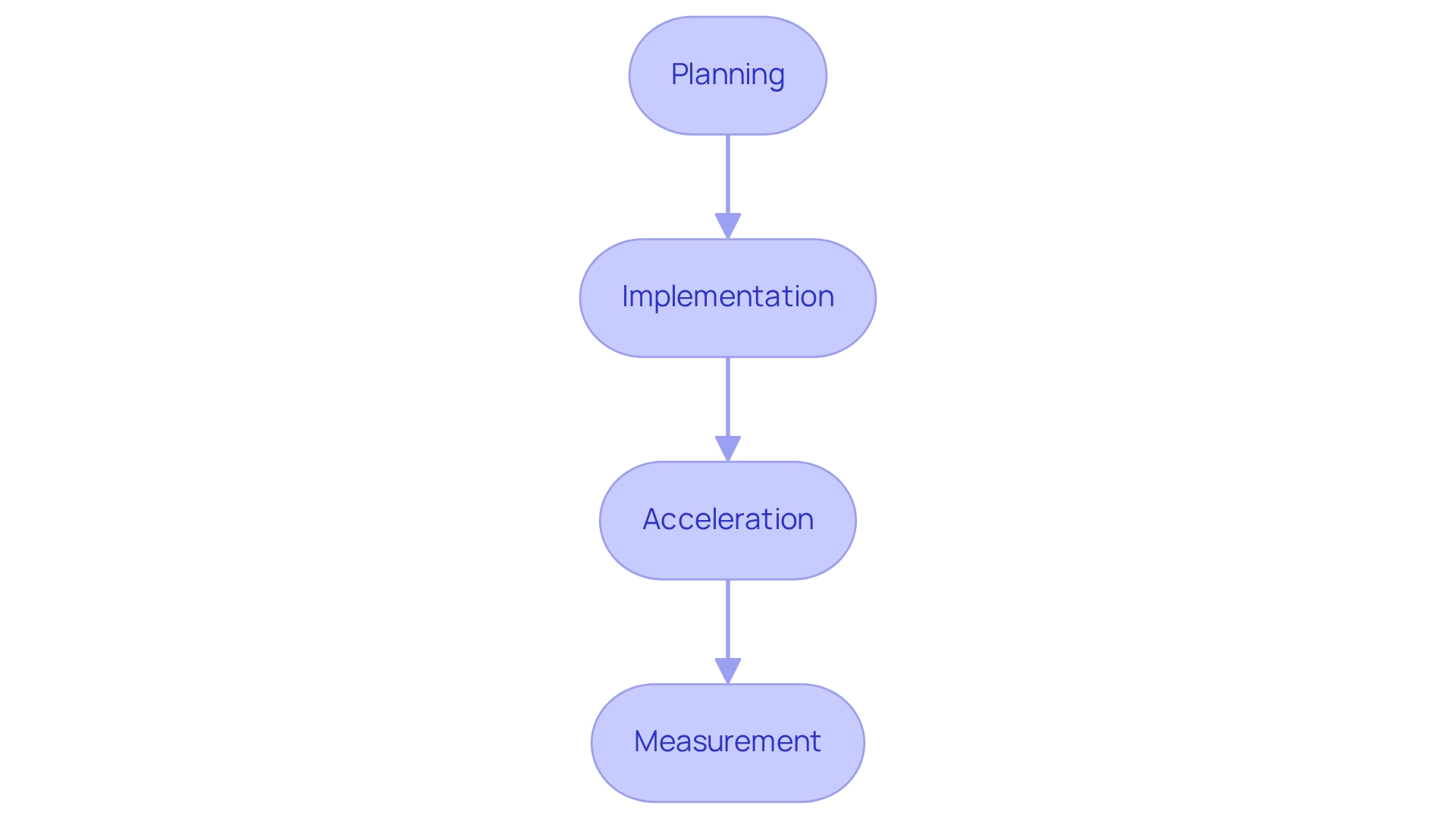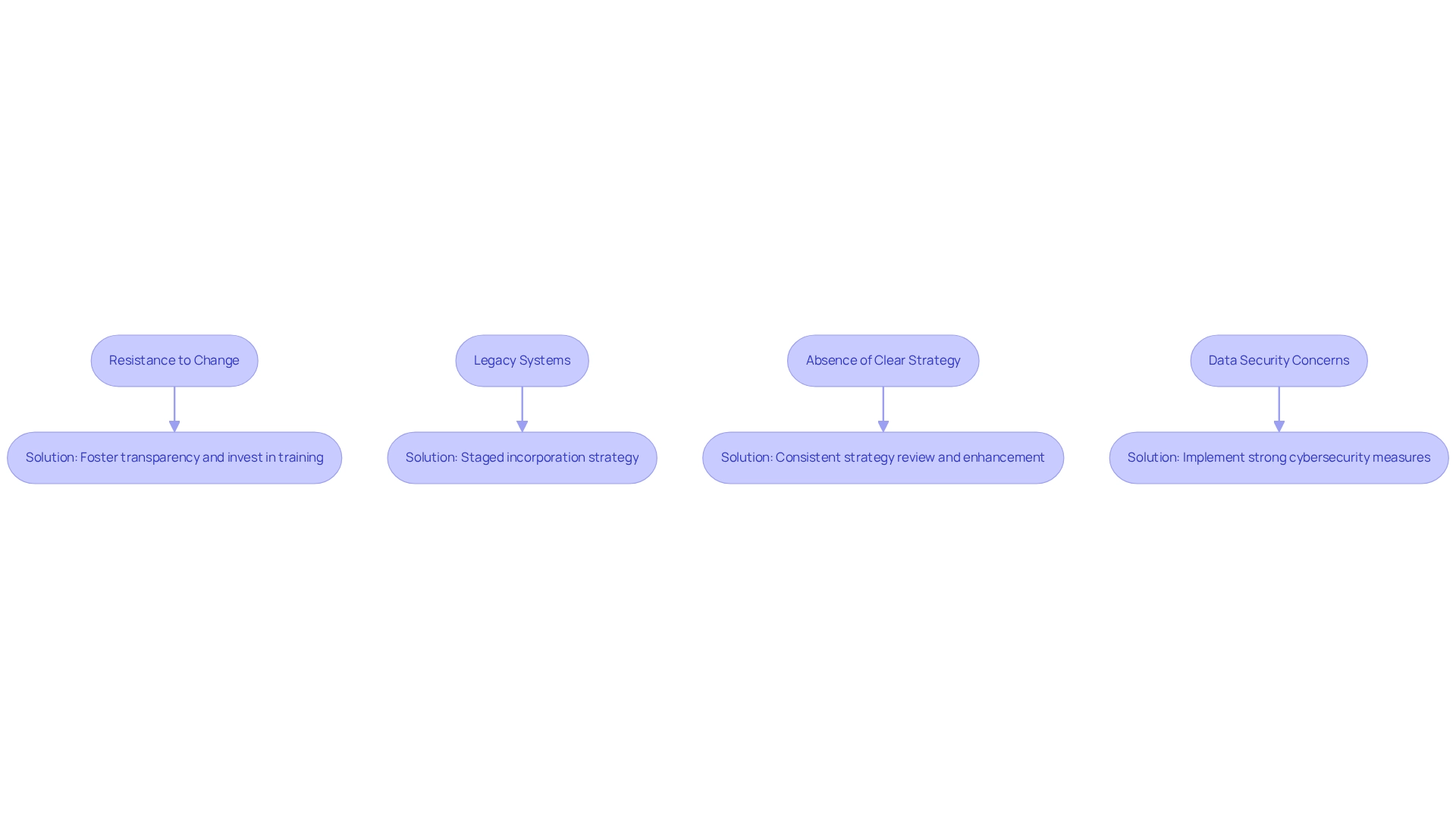Overview
Digital transformation is not just an option; it is a necessity for organizations aiming to thrive in today’s competitive landscape. The four stages of this transformation—Planning, Implementation, Acceleration, and Measurement—serve as a roadmap for effectively integrating technology into our operations. Each stage requires specific actions and strategies, such as:
- Assessing our current capabilities
- Adopting innovative technologies
- Optimizing processes
- Continuously evaluating performance
These steps are crucial for achieving successful technological change. What’s holding your team back from embracing this journey? We understand the challenges involved, but by navigating these stages with clarity and purpose, we can drive meaningful change and unlock significant value. Let’s embark on this transformative path together and ensure our organizations are well-equipped for the future.
Introduction
In an era defined by rapid technological advancements and shifting consumer expectations, we recognize that digital transformation is not merely an option; it is a vital strategy for organizations seeking to thrive. This comprehensive integration of digital technologies reshapes our operations, enhances customer experiences, and drives innovation across industries. As we face intensified competitive pressures, the need to embrace digital transformation becomes increasingly apparent.
From leveraging artificial intelligence for improved efficiency to navigating the complexities of legacy systems, we must adopt a structured approach to successfully transition into the digital age. This article delves into the significance of digital transformation, outlining the essential stages, actionable steps, and common challenges we encounter along the way, ultimately guiding us toward a future where we can not only survive but flourish.
Understand Digital Transformation and Its Importance
The shift to technology is not merely an option; it is a necessity for businesses aiming to thrive in today’s competitive landscape. As we navigate an online environment characterized by evolving customer demands and intensified competition, we must prioritize the thorough integration of technological advancements into our operations. This transformation is essential, not only for enhancing operational efficiency but also for significantly improving customer experiences and fostering innovation.
The recent NVIDIA 2025 State of AI in Financial Services survey reveals that:
- Nearly 70% of firms reported at least a 5% revenue increase attributable to AI implementations.
- Over 60% noted cost reductions of 5% or more.
This data underscores the critical need for us to incorporate AI into our online strategies to drive substantial business outcomes.
Consider the manufacturing sector during the pandemic: companies that were initially hesitant to adopt technological tools swiftly embraced e-commerce platforms and virtual sales meetings, demonstrating the agility required to adapt to new market conditions. This adaptability is particularly relevant for the banking sector, where electronic tools, including AI-powered chatbots and virtual assistants, can streamline operations and enhance customer interactions.
Furthermore, organizations investing in technological advancements can anticipate significant returns, with some reporting a 37% rise in sales revenue. As Petroc Taylor, a research expert, observes, ‘Many companies will turn to India to fulfill this demand, with the country leading a ranking of AI skills penetration,’ highlighting the global competition for technological talent.
Yet, we must also acknowledge the challenges posed by data and cybersecurity issues that hinder the secure and efficient utilization of information in digital transformation—an essential consideration for banking IT managers.
As we progress further into 2025, understanding the 4 stages of digital transformation will become increasingly important, making it a crucial focus for any organization striving to succeed in the digital era. Notably, producers are expected to allocate around 5% of their revenues to technological advancements, reflecting the financial commitment necessary for successful transformation.
To navigate this journey effectively, we encourage you to consider Avato’s Hybrid Integration Platform and adhere to a structured five-step guide to successful technological change.

Explore the Four Stages of Digital Transformation
The journey of technological change is organized around four essential stages that we must navigate:
- Planning: This foundational stage requires us to assess our current capabilities, establish clear objectives, and develop a strategic roadmap for change. It is essential to align our technological initiatives with business objectives and market needs, ensuring that the change is intentional and focused. As emphasized by Boston Consulting Group, prioritizing culture in digital change leads to outcomes five times more significant than other methods. Additionally, leveraging Avato’s Hybrid Integration Platform during this phase allows us to maximize and extend the value of our legacy systems, ensuring a comprehensive assessment and planning process that aligns with our institutional goals. Engaging stakeholders effectively and modeling new business processes are also vital steps in this phase to ensure all requirements are accurately captured.
- Implementation: During this phase, we actively execute our transformation strategies by adopting innovative technologies and refining processes. This frequently involves the combination of legacy systems with contemporary solutions, which is essential for improving operational efficiency and ensuring a smooth transition. Avato’s platform simplifies complex integrations, significantly reducing costs and providing real-time monitoring and alerts on system performance, which are essential for successful implementation.
- Acceleration: Following initial implementations, we shift our focus to scaling technological initiatives. This stage emphasizes process optimization, improving customer experiences, and utilizing data analytics to drive informed decision-making. As we adapt to evolving market conditions, we can significantly enhance our competitive edge.
- Measurement: The final stage involves a thorough evaluation of our transformation efforts. We should establish key performance indicators (KPIs) to assess progress and identify areas for improvement. Continuous measurement and adjustment are essential for sustaining momentum and achieving long-term success. A case study of Empresas CMPC demonstrates this point, as their incorporation of technological processes across their production chain resulted in enhanced operational visibility and better client service, showcasing how Avato’s platform can enable similar outcomes.
Current trends indicate that 70% of enterprises were planning to adopt a multi-cloud strategy in 2019, reflecting a shift towards more integrated and adaptable technological environments. Moreover, as emphasized by industry specialists, prioritizing a robust online culture can result in outcomes that are five times more significant than conventional methods.

Implement Actionable Steps for Each Stage
To effectively navigate the 4 stages of digital transformation, we must consider actionable steps that drive success.
In the planning phase of the 4 stages of digital transformation, we begin with a comprehensive assessment of existing technologies and processes to identify gaps and opportunities. Nearly 45% of executives believe their companies lack the essential tools to ensure digital change is successful, highlighting the necessity of this evaluation. By involving stakeholders throughout our organization, we gather insights and promote consensus on change objectives, particularly in preparation for open banking. Establishing clear goals and success indicators is crucial in steering our change process, ensuring coherence with the strategic unification methods essential for open banking.
In the implementation of the 4 stages of digital transformation, we select technologies that align with our business objectives and enhance customer experiences, ensuring they meet the specific needs of the banking sector. Our hybrid unification platform can streamline this process by utilizing existing legacy systems while minimizing risks associated with new implementations. A phased implementation approach is vital; we commence with pilot projects to validate new solutions before full-scale deployment. This strategy allows for adaptability and reduces potential disruptions. Furthermore, we offer robust training and assistance to our employees, as effective training programs significantly improve the success of transformation efforts. As Gustavo Estrada noted, “Avato has the ability to simplify complex projects and deliver results within desired time frames and budget constraints.”
Acceleration: We continuously monitor performance metrics and solicit user feedback to pinpoint areas for improvement in the 4 stages of digital transformation. Utilizing our expert connection services assists businesses in creating secure and dependable links between applications, essential for open banking. We harness data analytics to derive insights into customer behavior and operational efficiency, enabling informed decision-making. This is crucial for adjusting to the evolving landscape of online banking. Additionally, we foster an environment of innovation by motivating our teams to explore and test new technologies and concepts, particularly those that enhance connectivity features.
Measurement: Regularly reviewing key performance indicators (KPIs) allows us to evaluate the impact of the 4 stages of digital transformation initiatives on business outcomes. This process involves assessing the effectiveness of incorporation strategies and their alignment with open banking requirements. Adapting our strategies based on performance data and evolving market conditions ensures ongoing relevance and effectiveness. Our hybrid integration platform facilitates this adaptability by providing a structured approach to managing requirements and legacy systems. We celebrate our accomplishments and evaluate challenges to cultivate a mindset of ongoing development, emphasizing the significance of learning throughout the change process.

Identify Challenges and Solutions in Digital Transformation
Navigating the 4 stages of digital transformation presents several challenges that we must address effectively. Here are some common obstacles along with potential solutions:
-
Resistance to Change: Employee reluctance to embrace new technologies can impede progress. To tackle this, we should foster a culture of transparency and invest in extensive training programs that enable a smoother transition. Engaging employees early in the process can also help mitigate resistance.
-
Legacy Systems: Outdated systems often pose significant barriers to modernization. A staged incorporation strategy enables us to slowly enhance our technology framework, reducing interference with current activities. This strategy not only eases the transition through the 4 stages of digital transformation but also helps in effectively managing costs. For example, Avato’s hybrid unification platform has been commended for streamlining intricate unification projects, allowing organizations to modernize their systems effectively while guaranteeing secure transactions—a crucial aspect for banking and healthcare fields. As Tony LeBlanc from the Provincial Health Services Authority noted, “Avato accelerates the integration of isolated systems and fragmented data, delivering the connected foundation we need to simplify, standardize, and modernize.”
-
Absence of Clear Strategy: Organizations lacking a well-defined technological evolution plan may struggle to achieve the 4 stages of digital transformation. Consistently reviewing and enhancing our strategy ensures that teams stay focused and aligned with the overall vision. This iterative process can enhance adaptability in a rapidly changing environment.
-
Data Security Concerns: As new technologies are adopted, safeguarding data becomes increasingly critical. Implementing strong cybersecurity measures and following compliance protocols can considerably decrease risks linked to technological evolution. In reality, 93% of firms acknowledge that groundbreaking technologies, such as generative AI, are crucial for reaching their technological advancement goals. This technology has seen a 60% increase in use for enhancing customer experience through sophisticated chatbots and virtual assistants, which can also streamline operations and improve productivity. Furthermore, the worldwide electronic health market is anticipated to surpass 500 billion U.S. dollars by 2025, emphasizing the financial consequences of technological change in fields such as healthcare.
By proactively tackling these challenges, we can pave the way for successful technological transformation initiatives that align with the 4 stages of digital transformation, ultimately enhancing our operational capabilities and decreasing expenses. Furthermore, with 80% of Millennials more willing to purchase from brands that have a mobile customer service portal, modernizing our customer engagement strategies becomes crucial in this digital age.

Conclusion
Embracing digital transformation is no longer a luxury; it is a necessity for organizations like ours that aim to thrive in a rapidly evolving landscape. The integration of digital technologies across all facets of our business not only enhances operational efficiency but also significantly improves customer experiences and drives innovation. We cannot overstate the importance of a structured approach that encompasses:
- Planning
- Implementation
- Acceleration
- Measurement
Each stage plays a critical role in ensuring that our digital initiatives align with business objectives and market demands.
Furthermore, we must navigate various challenges, including resistance to change and legacy system limitations. By fostering a culture of openness and investing in training, we can mitigate resistance and ensure smoother transitions. Implementing phased integration strategies allows us to gradually modernize outdated systems, minimizing disruption and optimizing costs.
Ultimately, our journey towards digital transformation is a continuous process that requires adaptability, clear strategies, and a commitment to measuring success. As we invest in innovative technologies and refine our approaches, we position ourselves not just to survive but to flourish in the digital age. The future belongs to those of us who are willing to embrace change, harness the power of digital tools, and cultivate a culture of innovation that drives lasting success. Let us take this journey together, ensuring that we are not just participants but leaders in the digital transformation landscape.

